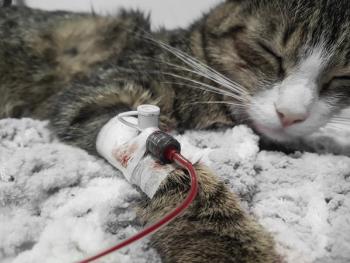
Fracture decision making – What can I reasonably do? (Proceedings)
A variety of approaches have been proposed to assist in making decisions regarding fracture management. At the most basic level, the task is to evaluate what is needed and then assess one's own capabilities. In so doing, fractures that one is properly able to manage can be dealt with appropriately and mistakes can be avoided that would prove detrimental to the patient.
A variety of approaches have been proposed to assist in making decisions regarding fracture management. At the most basic level, the task is to evaluate what is needed and then assess one's own capabilities. In so doing, fractures that one is properly able to manage can be dealt with appropriately and mistakes can be avoided that would prove detrimental to the patient. This session will assist practitioners in working through the decision making process and will also review some examples of easily managed fractures. It is assumed that members of the audience have an interest in orthopedics and a basic understanding of relevant techniques.
The decision making process
In general, the first step in understanding how to manage a fracture is to identify the type of fracture. The diagnosis is not generally difficult when quality radiographs are obtained. With that in mind, it is obviously important to have good equipment and to properly identify the area to be radiographed. There is no excuse for moving forward without obtaining the necessary films. As an aside, the assumption is being made that the entire patient has been assessed and appropriately managed with reference to cardiovascular, respiratory, neurologic and urinary systems as well as to any wounds or other soft-tissue injuries.
Based on radiographs, the clinician should be able to properly identify the location of the fracture (which bone and where on that bone), the type of fracture, the displacement or alignment, as well as whether it is likely to be open or closed. From this information, a good idea can be obtained as to which forces acting on the fracture must be addressed. Next, the clinician should consider the various management options, including coaptation and conservative care. Based on the inherent strengths and limitations of those methods, the simplest appropriate modality can be determined. If the only appropriate method is one with which the clinician has no expertise, the case should be referred. Additional complicating factors will also need to be considered such as other injuries, owner ability to provide post-operative care and presence of infection.
A number of mistakes of judgment may be made along the road to proper fracture management. Sometimes, practitioners are tempted to skimp on the radiographs. A minimum of two views should be obtained, and occasionally oblique views, skylines or advanced imaging may be necessary. Merely noting the presence of a fracture may not be sufficient. For example, noting whether a distal femoral fracture is a Salter I or II makes a huge difference in how it can be managed. Similarly, noting whether a fracture involves the caudal ilium or the ischium may be the determining factor in whether conservative management is appropriate. Another frequent error is the tendency to identify one fracture while missing other injuries. In addition to injuries such as hernias or urinary tract damage, multiple fractures may be present. The vast majority of animals with a single fracture should be able to stand or ambulate on the remaining three limbs. Failure to do so should prompt a thorough search for injuries to the spine or contralateral limb. Even more difficult to spot are additional injuries to the same limb. For example, a fracture of a femur may be obvious due to swelling or instability but the ipsilateral foot may have metatarsal fractures that could go unnoticed if the entire limb is not palpated carefully.
In general, practitioners should manage fractures that fall within the realm of their experience, expertise and equipment capabilities. This may be determined solely by the nature of the fracture or may be determined by the need to manage other injuries such as thoracic trauma. Examples of fractures that are simple to deal with include those that can be managed conservatively. These might include certain pelvic fractures or fractures to portions of the ulna or fibula. Additionally, many fractures can be managed with only external coaptation depending on their inherent stability and ability to heal quickly. Several examples will be given during the presentation. From a surgical standpoint, long oblique fractures can be repaired with pin and cerclage wire, and therefore are within the abilities of most clinicians. Avulsion fractures and many Salter-Harris fractures are also relatively simple. A variety of these cases will be reviewed and surgical tips will be given.
The addition of the capability to apply external fixators provides the clinician with a tremendously increased range of fractures to repair. Attendees are urged to attend the session on practical external fixator use at this conference.
Newsletter
From exam room tips to practice management insights, get trusted veterinary news delivered straight to your inbox—subscribe to dvm360.




